About the Exhibition
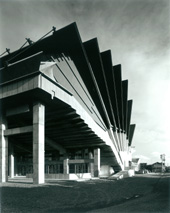
Kikutake Kiyonori
Miyakonojo Civic Center
1966
Miyazaki, Japan
Photo: Oyama Takashi
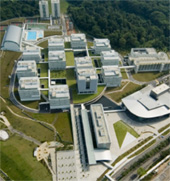
Maki Fumihiko
Republic Polytechnic
2007
Singapore
©Maki and Associates
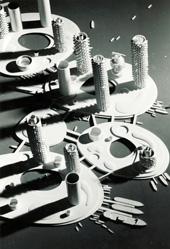
Kikutake Kiyonori
Marine City 1963
1963
The first retrospective of Metabolism, a movement born from the visions of architects
In the 1960s a group of Japanese architects dreamed of future cities and produced exciting new ideas. The visions of Kurokawa Kisho, Kikutake Kiyonori, Maki Fumihiko, and other architects who had come under the influence of Tange Kenzo gave birth to an architectural movement that was called "Metabolism." The name, taken from the biological concept, came from an image of architecture and cities that shared the ability of living organisms to keep growing, reproducing, and transforming in response to their environments. Their ideas were magnificent and surprising, with concepts such as marine cities that spanned Tokyo Bay, and cities connected by highways in the sky where automobiles pass between clusters of high-rise buildings.
Metabolism emerged at a time when Japan had recovered from the devastation of war and entered a period of rapid economic growth. People felt that creating ideal cities would be a way to build better communities. This exhibition is the very first to make a comprehensive examination of Metabolism. Japan is now facing big decisions about its future. It is a perfect time to learn about the Metabolism movement and discover some of its many hints for architecture and cities.
The exhibition is organized in four sections, plus the Metabolism Lounge.
Section 1: Birth of Metabolism
Metabolism was an architectural movement that began in Japan but impacted the whole world. Tange Kenzo, who thought of architecture on the scale of cities, had a particularly strong influence on the birth of Metabolism. This section examines Tange's reconstruction plan? Master Plan for Hiroshima and Hiroshima Peace Center Complex ?which is the clear starting point for postwar Japanese architecture and urban design. It also traces the changes in wartime and postwar Japanese urban design, focusing in particular on the ideas for future cities set out in 1960 in the manifesto, "METABOLISM/1960 - The Proposals for a New Urbanism".
Section 2: Era of Metabolism
The ideas of Metabolism progressed from being unrealized plans for futuristic cities, and some took form as experimental architecture. This section reviews a wide range of activities from conceptual city plans to public architecture and housing, including A Plan for Tokyo?1960 which set out Tange Kenzo and his associates' innovative ideas for a marine city to span Tokyo Bay, the Nakagin Capsule Tower Building, which became a symbol of Metabolism by demonstrating urban housing in the form of detachable capsules, and Syowa Station, the Antarctic base that could be assembled on site without special skills using factory-made components, a precursor of today's prefabricated housing.
Section 3: From Space to Environment
In addition to architecture and urban planning, Metabolism became deeply involved in design and art via the 'environment' keyword. One result of that involvement was the "From Space to Environment" exhibition in 1966. Another example is Osaka Expo '70, which integrated many different genres in events on the 'environment' theme. This section exhibits the works of artist Yamaguchi Katsuhiro, graphic designer Awazu Kiyoshi and others who participated in "From Space to Environment." It also introduces Expo '70 from an urban planning and architectural perspective.
Section 4: Global Metabolism
From about the time of Expo '70, Tange Kenzo and other Metabolism architects began working at the international level. They have since produced projects around the world that put the ideas of Metabolism into practice in many different forms. Here we examine major projects at the city scale, including Tange Kenzo's Master Plan for Reconstruction of Skopje City Center in Macedonia, and Maki Fumihiko's Republic Polytechnic. Including unrealized projects and projects that are still in progress, we attempt to verify the extent to which Metabolism has contributed to the growth of cities around the world, and particularly in Asia.
Metabolism Lounge - current ideas on future city models
Taking a variety of forms, the thinking and ideas of Metabolism are still very much alive in architecture and urban design today. The Metabolism Lounge includes exhibits showing Ekuan Kenji's disaster relief units (the QS72 temporary structures designed by GK Sekkei) that were used in hospitals after the East Japan Earthquake, and research from Shimizu Corporation's GREEN FLOAT project, which has inherited many of its approaches from Metabolism. The Lounge also has many books related to Metabolism and urban design, and will have videos of the symposiums held during the exhibition period, making it the ideal venue for thinking about the future of architecture and the cities produced by the ideas of Metabolism.
* Due to events, the Metabolism Lounge will not be available on Sat, 17 September /
Thu, 6 October / Mon, 17 October / Thu, 27 October - Tue, 8 November / Sat, 19 November / Fri, 25 November / Thu, 1 December / Tue, 6 December / Sat, 10 December / Thu, 15 December
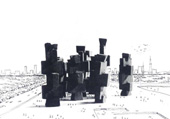
Otaka Masato, Maki Fumihiko
Group Form
1960
Tokyo
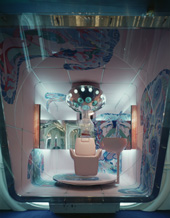
Kurokawa Kisho
Takara Beautilion, Expo '70
1970
Photo: Shinkenchiku-sha
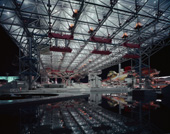
Festival Plaza, Expo'70
1970
Osaka
Photo: Shinkenchiku-sha
![MORI ART MUSEUM EXHIBITION [METABOLISM: THE CITY OF THE FUTURE - Dream and Visions of Reconstruction in Pastwar and Present-Day Japan]](../i/header.jpg)